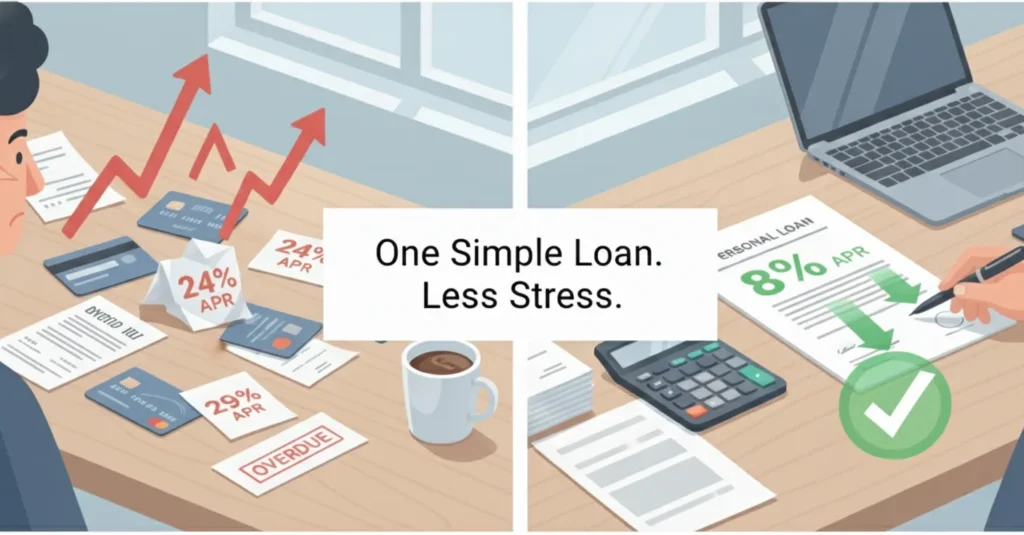Debt can feel heavy, not just on your wallet but on your mind. When you’re managing multiple credit card bills, each with different due dates, high interest rates, and minimum payments that never seem to reduce the balance, it can feel overwhelming. You make payments every month, but your debt doesn’t shrink—it grows. The truth is, credit card debt is designed to keep you paying interest, not to help you get debt-free.
But there is a solution that provides structure, clarity, and a real end date: using a personal loan for debt consolidation.
This strategy simplifies your debt by combining multiple high-interest balances into one fixed-rate loan with a predictable payment and a clear payoff schedule. It creates a path to real financial progress and finally breaks the cycle of revolving debt.

What Is Debt Consolidation Using a Personal Loan?
Debt consolidation is the process of taking several debts—often credit cards with high interest—and replacing them with a single personal loan at a lower fixed interest rate. Instead of managing multiple debts at 20 to 28 percent APR, you replace them with one loan typically between 8 and 14 percent.
Old Way: Multiple payments, unpredictable interest, no payoff date, constant stress
New Way: One payment, fixed interest, clear payoff schedule, easier to manage
Unlike credit cards, which have variable rates and no defined payoff timeline, personal loans offer consistency and certainty.
Why Credit Card Debt Is Hard to Escape
Credit cards operate on revolving debt. That means you can borrow, pay, and reborrow indefinitely. When you only make minimum payments, most of your money goes toward interest—not the principal balance. As a result, you may feel like you’re always paying but never actually reducing your debt.
Example: $8,000 in credit card debt at 23% APR
| Payment Method | Monthly Payment | Time to Pay Off | Total Interest Paid |
|---|---|---|---|
| Minimum Payments | $200 | 15+ years | $11,000+ |
| Personal Loan at 11% APR | $262 | 36 months | ~$1,350 |
Saving by using a personal loan: Over $9,600
This example shows that the biggest cost isn’t your debt—it’s the type of debt you’re using.
How a Personal Loan Changes Everything
When you use a personal loan for debt consolidation, everything becomes simpler.
You get one predictable monthly payment.
You get a fixed interest rate.
You get a clear debt-free date.
You pay far less interest.
You break the cycle of revolving debt.
Most importantly, instead of guessing when your debt will end, you know the exact month and year you’ll be debt-free. That provides motivation and peace of mind.
Real-Life Example: How Kevin Saved Over $6,000 Using a Personal Loan
Kevin had three high-interest credit cards:
| Debt Type | Balance | APR |
|---|---|---|
| Chase Credit Card | $3,500 | 21% |
| Discover Card | $4,000 | 24% |
| Store Card | $2,200 | 25% |
His monthly payments totaled $350, but his balance barely moved. After consolidating into one personal loan at 10.9 percent, things changed dramatically.
| Before (Credit Cards) | After (Personal Loan) |
|---|---|
| ~$350/month (varies) | $298/month (fixed) |
| No payoff date | Paid in 36 months |
| Over $7,800 in interest | ~$1,400 interest |
| Stressful and confusing | Simple and structured |
Total interest saved: More than $6,400
Debt-free date: January 2027
Most importantly, Kevin felt in control of his financial future.
Who Should Consider Debt Consolidation?
You may benefit from a personal loan for debt consolidation if:
You have multiple debts: credit cards, medical bills, personal loans, or payday loans
Your average APR is above 17 percent
You’re making minimum payments but not reducing your balance
You want one structured monthly payment
Your credit score is at least 620
You want a clear payoff date and financial control
When Debt Consolidation Might Not Be the Best Option
It may not be ideal if:
Your credit score is below 580 (you may not qualify for lower rates)
You continue adding new debt every month
You don’t have stable income
You plan to continue using your paid-off cards
If your credit score is between 580 and 650, it may be worth improving it for 60 to 90 days before applying. Even a small score improvement may help you qualify for a much better rate.
What a Debt Consolidation Loan Really Does
Here’s how a structured personal loan compares to ongoing credit card debt:
| Feature | Credit Cards | Personal Loan |
|---|---|---|
| Interest Type | Variable | Fixed |
| APR Range | 18–29% | 6–14% |
| Monthly Payment | Varies | Fixed |
| Payoff Date | Unknown | Defined |
| Emotional Impact | Stressful | Motivating |
With a personal loan, your debt becomes structured, predictable, and easier to manage.
Step-by-Step: How to Consolidate Using a Personal Loan
Step 1: List all your debts by balance, interest rate, lender, and monthly payment.
| Lender | Balance | APR | Monthly Payment |
|---|---|---|---|
| Citi | $2,800 | 23% | $92 |
| Capital One | $3,200 | 21% | $97 |
| Store Card | $1,700 | 25% | $70 |
Total debt: $7,700
Average APR: 23.4%
Step 2: Pre-qualify for personal loan offers using soft credit checks (which don’t impact your score).
Step 3: Compare loan terms. Look for competitive APR, reasonable repayment period, no prepayment penalty, and no hidden fees.
Step 4: Pay off your credit cards using the loan funds. Some lenders pay them directly on your behalf.
Step 5: Commit to one fixed monthly payment until fully paid off.
Step 6: Avoid using the credit cards you just paid off unless you can pay them off in full each month. Otherwise, you risk going further into debt.
Does Debt Consolidation Affect Your Credit Score?
Consolidation can help improve your score in the long run by:
Lowering your credit utilization rate
Adding installment debt to your credit mix
Helping you build a strong payment history
You may see a small dip due to the credit pull, but it often recovers and improves within months.
Debt Consolidation vs. Balance Transfer vs. Debt Settlement
Balance transfer credit cards can be useful if:
You have excellent credit (usually 700 or higher)
You can pay off debt during the 0 percent introductory period
You understand the transfer fees and post-promo rates
Debt settlement is often a last resort, as it can negatively impact your credit and may involve paying less than you owe.
For most people with $5,000 to $50,000 in debt, a personal loan for debt consolidation is the most practical, structured, and financially beneficial solution.
The Emotional Benefits of Debt Consolidation
Debt is not only a financial burden—it can be mentally draining.
Many people report lower stress, better sleep, improved financial confidence, and stronger motivation when they switch from unstructured credit card payments to a structured loan plan.
Knowing you will be debt-free in a specific number of months makes your goal real and achievable.
Final Thought: Debt Consolidation Is About Control, Not Just Money
Debt consolidation using a personal loan doesn’t magically fix everything, but it does give you clarity, structure, and a clear path to financial freedom.
It turns unknown into known.
It turns endless into scheduled.
It turns stress into confidence.
Your debt does not define you. What matters is your decision to take control of it.
Want to Know How Much You Can Save on Your Debt?
Understanding your debt and how it grows with interest can be overwhelming. By looking at:
- Your total debt
- Your average interest rate
- Your current monthly payment
You can see clearly:
- Your estimated new monthly payment
- Your approximate interest savings
- Your projected debt-free date
Even small adjustments to how you manage your payments can make a big difference over time. Knowing these numbers can help you plan smarter, reduce stress, and move closer to being debt-free sooner.

